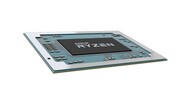AMD Athlon Silver 3050e vs Intel Core i5-8200Y
AMD Athlon Silver 3050e
► remove from comparison
The AMD Athlon Silver 3050e (Codename Dali) is a mobile APU that integrates two Zen cores (with SMT, therefore 4 threads) clocked at 1.4 to 2.8 GHz. The TDP is specified at 6 Watt and therefore the chip can be passively cooled. The integrated Radeon graphics card offers 3 CUs at up to 1000 MHz (Radeon RX Vega 3). The dual channel memory controller supports only DDR4-2400. The chip is manufactured on a 14 nm node and officially counted to the 3000 series of mobile processors.
More information on Raven Ridge can be found in our launch article.
Performance
The average 3050e in our database is in the same league as the Celeron N4120, as far as multi-thread benchmark scores are concerned. In other words, a slight amount of the AMD Zen magic has not helped this chip much. Its performance can be described as fairly slow, as of mid 2023.
Your mileage may vary depending on how high the CPU power limits are.
Power consumption
Much like Intel's N-class Celeron and Pentium processors, the AMD 3050e has a 6 W TDP (also known as the long-term power limit). This is not much at all and thus good enough for passively cooled tablets, laptops, mini-PCs.
This APU is built with a 14 nm process making for poor, as of early 2023, energy efficiency.
Intel Core i5-8200Y
► remove from comparisonThe Intel Core i5-8200Y is a very efficient dual-core SoC for tablets and passively cooled notebooks based on the Amber Lake generation and was announced on 28th August 2018. The CPU consists of two processor cores clocked at 1.3 - 3.9 GHz. Thanks to Hyper Threading, the processor can execute up to four threads simultaneously. The chips also includes the Intel HD Graphics 615 GPU, a dual-channel memory controller (DDR3L/LPDDR3) as well as VP9 and H.265 video de- and encoder. Compared to the Kaby Lake-Y predecessors (e.g. Core i7-7Y75), Amber Lake uses the same architecture produced in the improved 14nm+ FinFET process (no 14nm++) but offers higher clock speeds at an increased TDP rating.
Architecture
Intel basically used the familiar micro architecture from the Skylake / Kaby Lake generation, so the per-MHz performance is identical.
Performance
The performance of the Y series is highly depending on the cooling solution of the laptop / tablet and the TDP settings for sustained load. Therefore, the differences between a Core m3 and a i7 may be rather slim, if the thermals are very limited. The high Turbo clock speeds in Amber Lake should however lead to a very good single thread performance for short bursts.
Graphics
The integrated Intel HD Graphics 615 GPU has 24 Execution Units (EUs) like the old HD Graphics 515 and runs with clocks between 300 and 950 MHz in combination with this processor. The performance heavily depends on the TDP limit as well as the memory configuration; with fast LPDDR3-1866 RAM in dual-channel mode, the GPU should sometimes be able to compete with the HD Graphics 520, but can also be much slower in other scenarios. Modern games from 2016 will, if at all, only run smoothly in the lowest settings.
Contrary to Skylake, Kaby Lake and Amber Lake now also supports hardware decoding for H.265/HEVC Main10 with a 10-bit color depth as well as Google's VP9 codec.
Power Consumption
The chip is manufactured in the 14 nm+ process with FinFET transistors. The typical TDP for the Amber Lake Y-series is specified at 5 Watts (previous generations were 4.5 Watt), and can be adjusted in both directions depending on the usage scenario.
| Model | AMD Athlon Silver 3050e | Intel Core i5-8200Y | ||||||||||||||||||||||||||||||||||||||||||||
| Codename | Dali (Zen) | Amber Lake-Y | ||||||||||||||||||||||||||||||||||||||||||||
| Series | AMD Raven Ridge (Ryzen 2000 APU) | Intel Amber Lake | ||||||||||||||||||||||||||||||||||||||||||||
| Series: Amber Lake Amber Lake-Y |
|
| ||||||||||||||||||||||||||||||||||||||||||||
| Clock | 1400 - 2800 MHz | 1300 - 3900 MHz | ||||||||||||||||||||||||||||||||||||||||||||
| L1 Cache | 192 KB | 128 KB | ||||||||||||||||||||||||||||||||||||||||||||
| L2 Cache | 1 MB | 512 KB | ||||||||||||||||||||||||||||||||||||||||||||
| L3 Cache | 4 MB | 4 MB | ||||||||||||||||||||||||||||||||||||||||||||
| Cores / Threads | 2 / 4 | 2 / 4 | ||||||||||||||||||||||||||||||||||||||||||||
| TDP | 6 Watt | 5 Watt | ||||||||||||||||||||||||||||||||||||||||||||
| Technology | 14 nm | 14 nm | ||||||||||||||||||||||||||||||||||||||||||||
| Socket | FP5 | BGA | ||||||||||||||||||||||||||||||||||||||||||||
| Features | DDR4-2400 RAM, PCIe 3, MMX, SSE, SSE2, SSE3, SSSE3, SSE4A, SSE4.1, SSE4.2, AVX, AVX2, BMI2, ABM, FMA, ADX, SMEP, SMAP, SMT, CPB, AES-NI, RDRAND, RDSEED, SHA, SME | Dual-Channel DDR3L-1600/LPDDR3-1866 Memory Controller, HyperThreading, AVX, AVX2, Quick Sync, Virtualization, AES-NI, vPro, TXT | ||||||||||||||||||||||||||||||||||||||||||||
| iGPU | AMD Radeon RX Vega 3 ( - 1000 MHz) | Intel UHD Graphics 615 (300 - 950 MHz) | ||||||||||||||||||||||||||||||||||||||||||||
| Architecture | x86 | x86 | ||||||||||||||||||||||||||||||||||||||||||||
| Announced | ||||||||||||||||||||||||||||||||||||||||||||||
| Manufacturer | www.amd.com | |||||||||||||||||||||||||||||||||||||||||||||
| max. Temp. | 100 °C |
Benchmarks
Average Benchmarks AMD Athlon Silver 3050e → 100% n=4
Average Benchmarks Intel Core i5-8200Y → 158% n=4
* Smaller numbers mean a higher performance
1 This benchmark is not used for the average calculation













